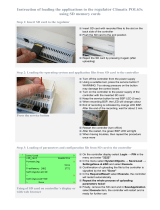
Board Support Package ModARM9 for Windows CE 5.00
Table of Contents
1 History ...........................................................................................................................5
2 Preface ..........................................................................................................................5
3 License Backround........................................................................................................6
4 Contents of the CD........................................................................................................ 7
5 Installation of the Board Support Package.................................................................... 8
6 Creating a new platform ................................................................................................ 9
6.1 Platform settings .............................................................................................. 14
6.1.0 Build options ....................................................................................... 14
6.1.1 Language settings ..............................................................................14
6.1.2 Environment Variables........................................................................ 15
6.2 Include virtual Keyboard ..................................................................................16
6.3 Including USB HID keyboard support .............................................................. 17
6.4 Building the Platform........................................................................................ 17
6.5 Modify CONFIG.BIB......................................................................................... 18
7 Download of the image to the target ........................................................................... 19
7.1 U-Boot .............................................................................................................. 19
7.2 Abilities............................................................................................................. 19
7.3 U-Boot Options................................................................................................. 20
7.4 TFTP ................................................................................................................ 20
7.5 Terminal configuration...................................................................................... 21
7.6 Download Kernel through Ethernet.................................................................. 22
7.7 Debug over Ethernet........................................................................................ 22
7.8 Copy Kernel image to Flash............................................................................. 24
7.8.1 Configure start of Kernel image in Flash ............................................ 25
7.9 JTAG Booster................................................................................................... 25
8 Kernel Debugging........................................................................................................ 26
8.1 Sharing Ethernet Debugging Services............................................................. 27
8.2 Run Time Debugging ....................................................................................... 28
9 Remote Tools .............................................................................................................. 29
10 Windows CE directory tree.......................................................................................... 30
10.1 %_WINCEROOT%\PLATFORM...................................................................... 30
10.2 %_WINCEROOT%\PBWorkspaces.................................................................30
10.3 %_WINCEROOT%\PUBLIC\COMMON .......................................................... 30
10.4 Important file types........................................................................................... 30
11 CE component file ....................................................................................................... 31
12 Drivers .........................................................................................................................32
12.1 Display ............................................................................................................. 32
12.1.1 Modify Display Driver.......................................................................... 32
12.2 Ethernet............................................................................................................ 32
12.3 USB Host ......................................................................................................... 33
12.4 Touch ............................................................................................................... 33
12.5 IP2REG ............................................................................................................ 33
12.6 CPU.................................................................................................................. 33
13 Common Hints............................................................................................................. 34
13.1 Automatically start of applications....................................................................34
13.2 Telnet server .................................................................................................... 34
13.3 FTP server ....................................................................................................... 35
14 Creating a Software Development Kit (SDK) .............................................................. 36
15 Insert Existing Projects................................................................................................ 38
16 Developing Applications with Embedded Visual C++ ................................................. 39
16.1 Creating a new project ..................................................................................... 39
16.2 Downloading the Application to the Target ......................................................40
3




















